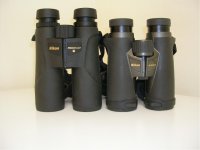FalcoSingh
Well-known member
So what are the key differences between:
Monarch Mk 3
Monarch 3
ProStaff 7
I know the new Monarch 3 will replace the the Monarch Mk 3 but can't understand how the new ProStaff 7 fits-in. I also know that Nikon are in a transition phase where product lines are being aesthetically aligned. But some things still don't make sense.
For instance comparing official specs between Monarch Mk 3 (MM3) and ProStaff 7 (PS7) here's all the differences I can find (8x42 models):
- MM3 - dielectric coated
prism, 8.2ft close focussing, 19.5mm eye relief, 5.7 x 5 inches size, 21.5oz weight, $299.95 estimated selling price.
- PS7 - aluminium coated prism, 13.1ft close focussing, 19.3mm eye relief, 6.9 x 5.1 inches size, weight not mentioned but probably higher, estimated selling price not mentioned but perhaps slightly cheaper.
I didn't include the Monarch 3 as it's not on Nikon's official sites and I didn't want to rely on 2nd hand info - either that or I am going blind! However the only differences I have heard are that apparently it features silver-coated prisms. Also apparently it featured a polycarbonate body - as opposed to the MM3 which I believe has a magnesium alloy body. Who knows what the PS7 is made of. The very misty plot thickens!
It's really unclear as to how the Monarch 3 and PS7 will co-exist in terms of differing comsumer needs. Clarification is needed so consumers don't feel slightly peeved especially over the next few months.
Nikon, throw me a bone! I am based in the UK and very recently purchased the MM3 and if either of the other two are better for my specific needs, I can return my current bins to Amazon but not for very long.
Some of my most pressing questions:
- dielectric / silver / aluminium: which prism coatings are better?
- given the PS7 is no doubt bigger and probably heavier than the Monarch 3 (it's certainly bigger than the soon to be outgoing MM3), was this a design compromise in order to achieve a 'better' image of some sort?
Or is the PS7 simply a slightly poorer man's Monarch?
If the resident Nikon rep could detail the spec differences between the three models mentioned, and the thinking behind launching the Monarch 3 alongside the PS7, I would be really grateful.
Ps - I have just seen this thread which talks about some image differences but it doesn't answer all the above questions:
http://www.birdforum.net/showthread.php?t=202792
Many thanks,
Atma Singh
Monarch Mk 3
Monarch 3
ProStaff 7
I know the new Monarch 3 will replace the the Monarch Mk 3 but can't understand how the new ProStaff 7 fits-in. I also know that Nikon are in a transition phase where product lines are being aesthetically aligned. But some things still don't make sense.
For instance comparing official specs between Monarch Mk 3 (MM3) and ProStaff 7 (PS7) here's all the differences I can find (8x42 models):
- MM3 - dielectric coated
prism, 8.2ft close focussing, 19.5mm eye relief, 5.7 x 5 inches size, 21.5oz weight, $299.95 estimated selling price.
- PS7 - aluminium coated prism, 13.1ft close focussing, 19.3mm eye relief, 6.9 x 5.1 inches size, weight not mentioned but probably higher, estimated selling price not mentioned but perhaps slightly cheaper.
I didn't include the Monarch 3 as it's not on Nikon's official sites and I didn't want to rely on 2nd hand info - either that or I am going blind! However the only differences I have heard are that apparently it features silver-coated prisms. Also apparently it featured a polycarbonate body - as opposed to the MM3 which I believe has a magnesium alloy body. Who knows what the PS7 is made of. The very misty plot thickens!
It's really unclear as to how the Monarch 3 and PS7 will co-exist in terms of differing comsumer needs. Clarification is needed so consumers don't feel slightly peeved especially over the next few months.
Nikon, throw me a bone! I am based in the UK and very recently purchased the MM3 and if either of the other two are better for my specific needs, I can return my current bins to Amazon but not for very long.
Some of my most pressing questions:
- dielectric / silver / aluminium: which prism coatings are better?
- given the PS7 is no doubt bigger and probably heavier than the Monarch 3 (it's certainly bigger than the soon to be outgoing MM3), was this a design compromise in order to achieve a 'better' image of some sort?
Or is the PS7 simply a slightly poorer man's Monarch?
If the resident Nikon rep could detail the spec differences between the three models mentioned, and the thinking behind launching the Monarch 3 alongside the PS7, I would be really grateful.
Ps - I have just seen this thread which talks about some image differences but it doesn't answer all the above questions:
http://www.birdforum.net/showthread.php?t=202792
Many thanks,
Atma Singh
Last edited:





